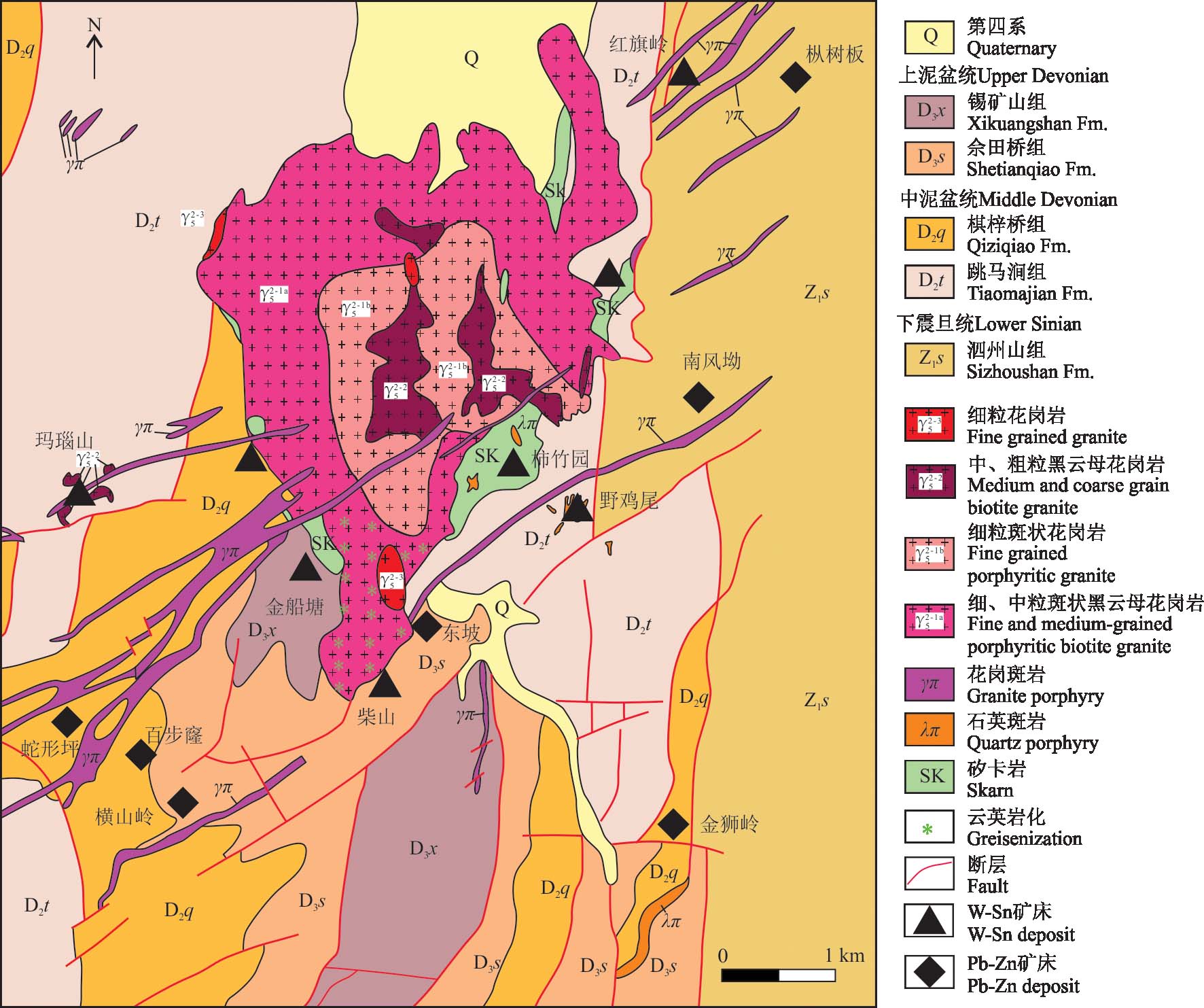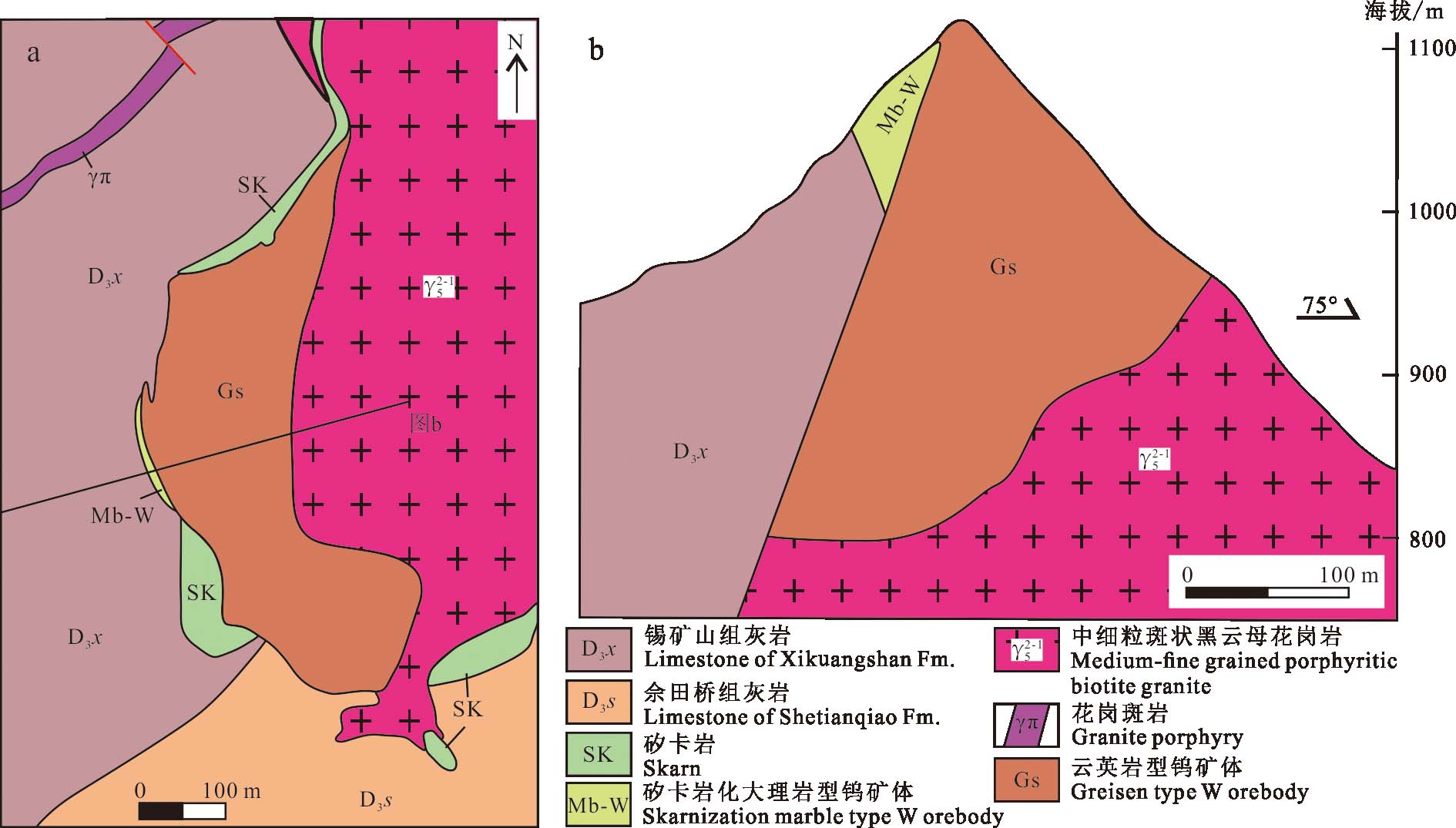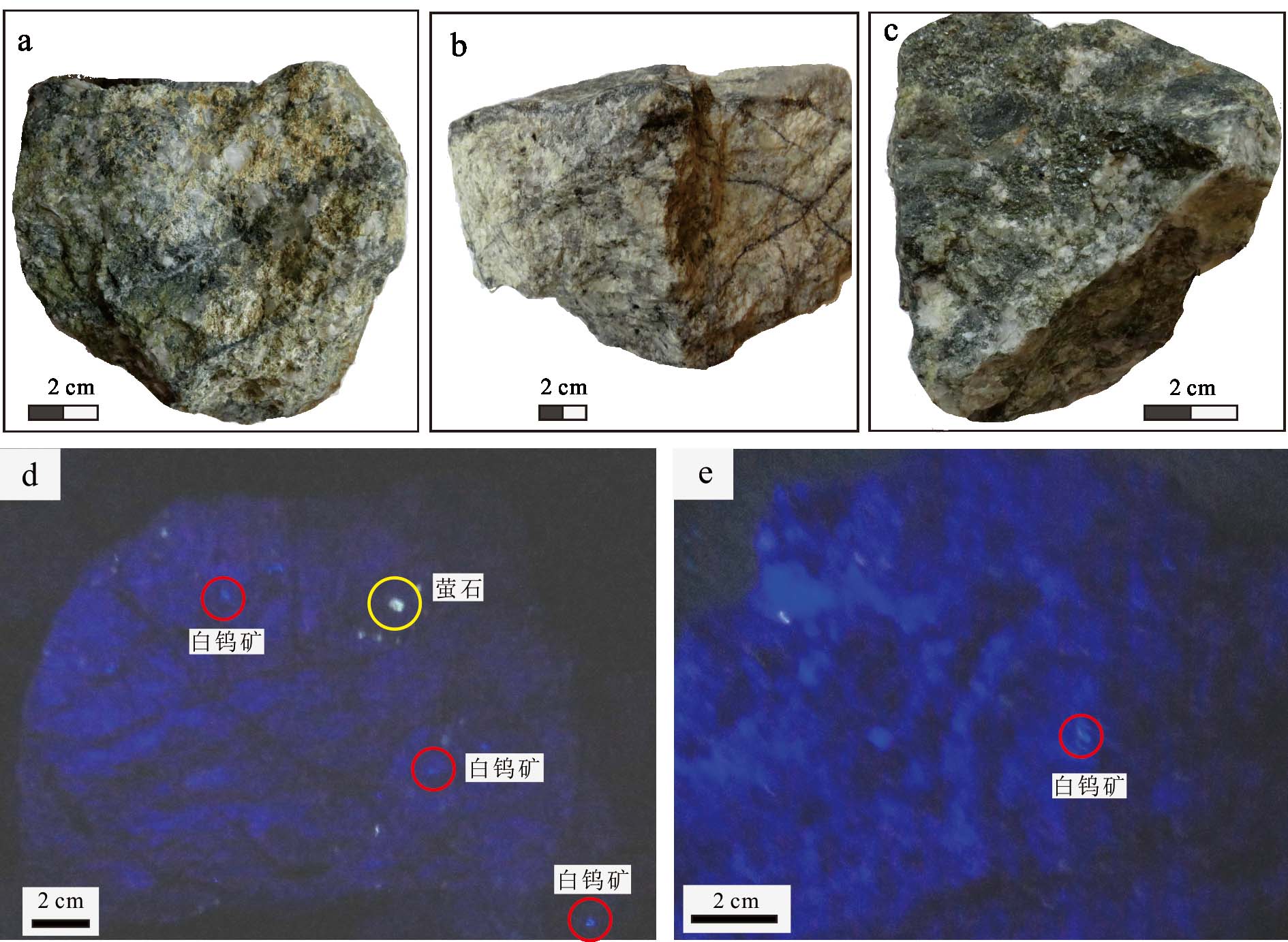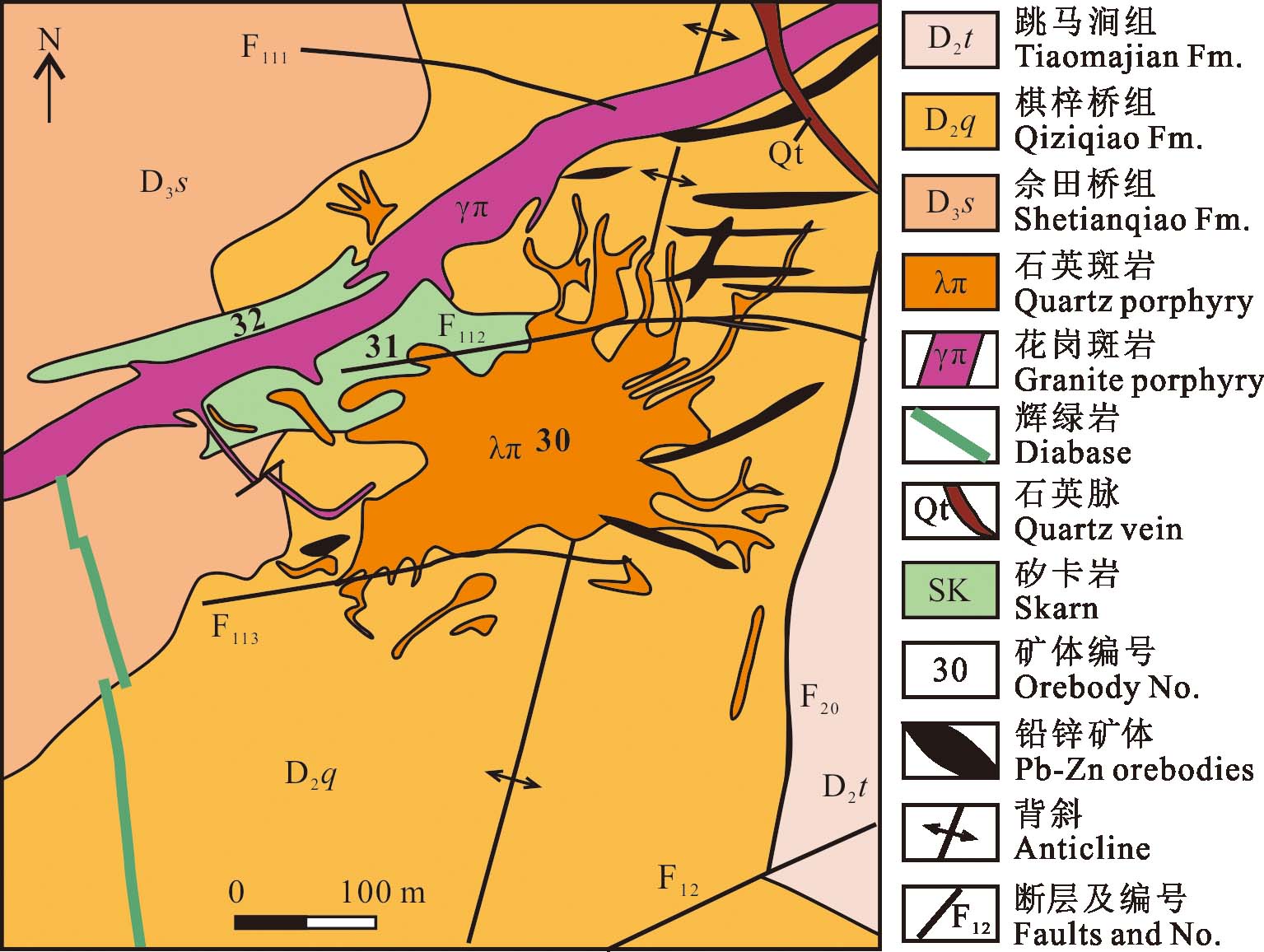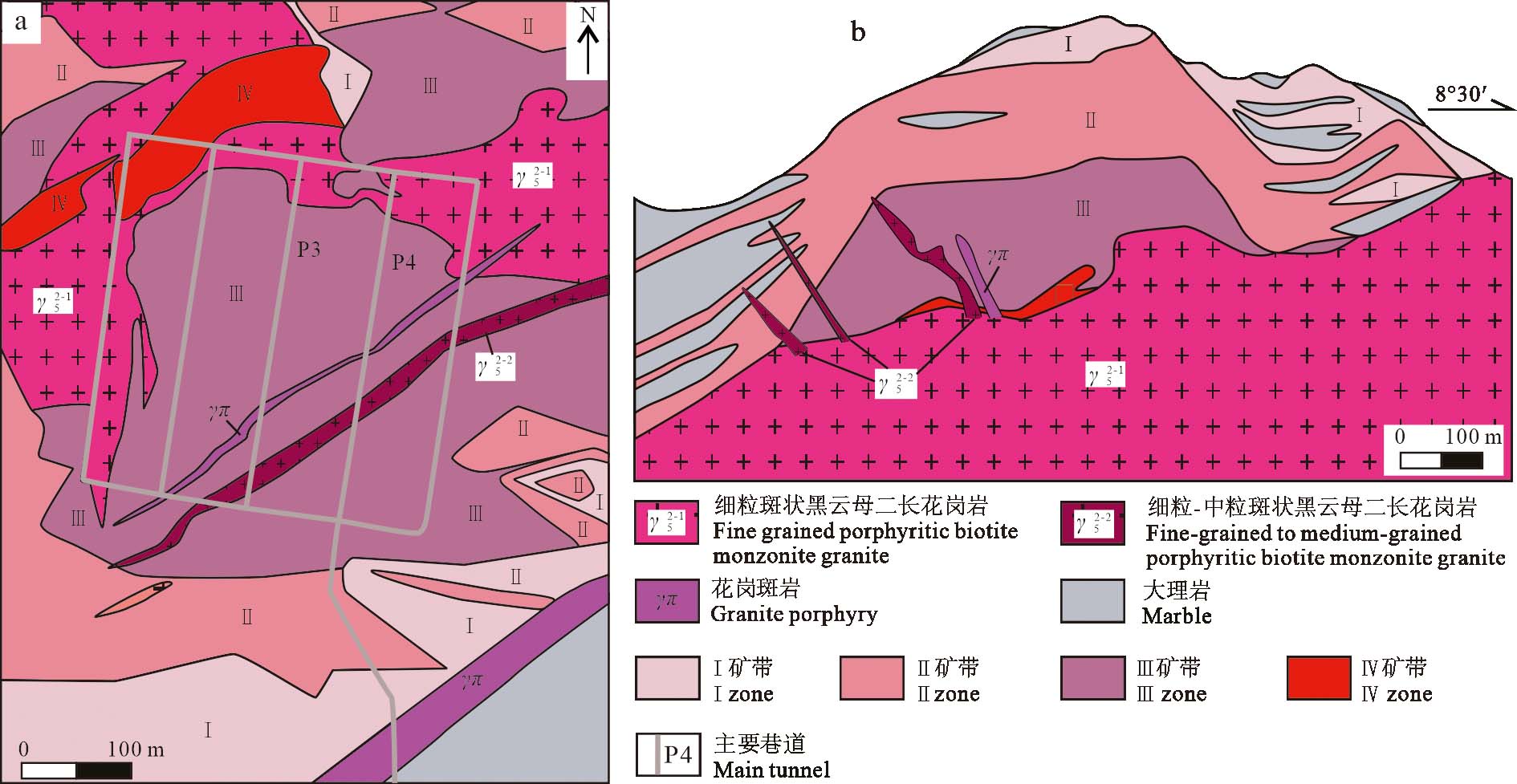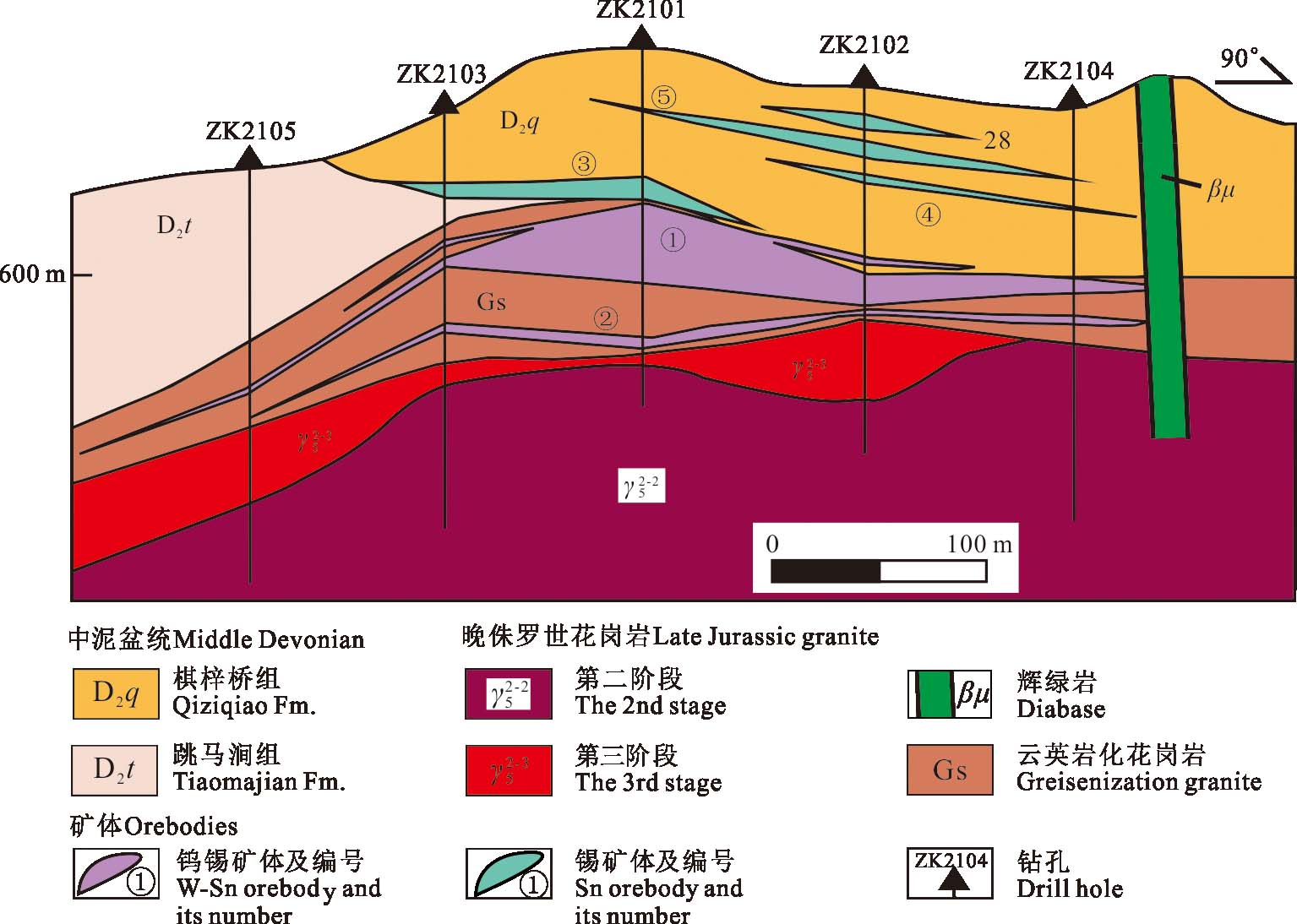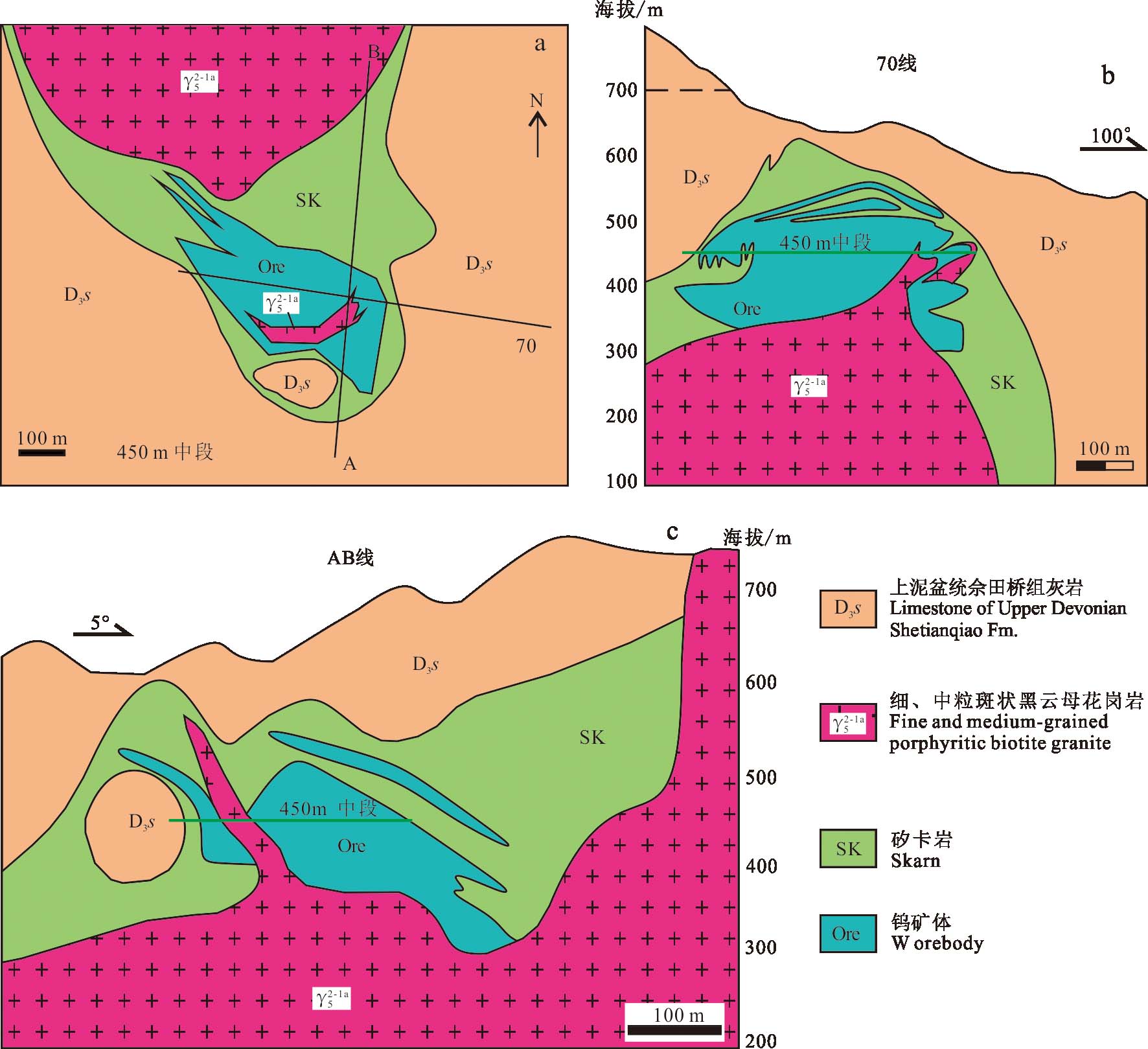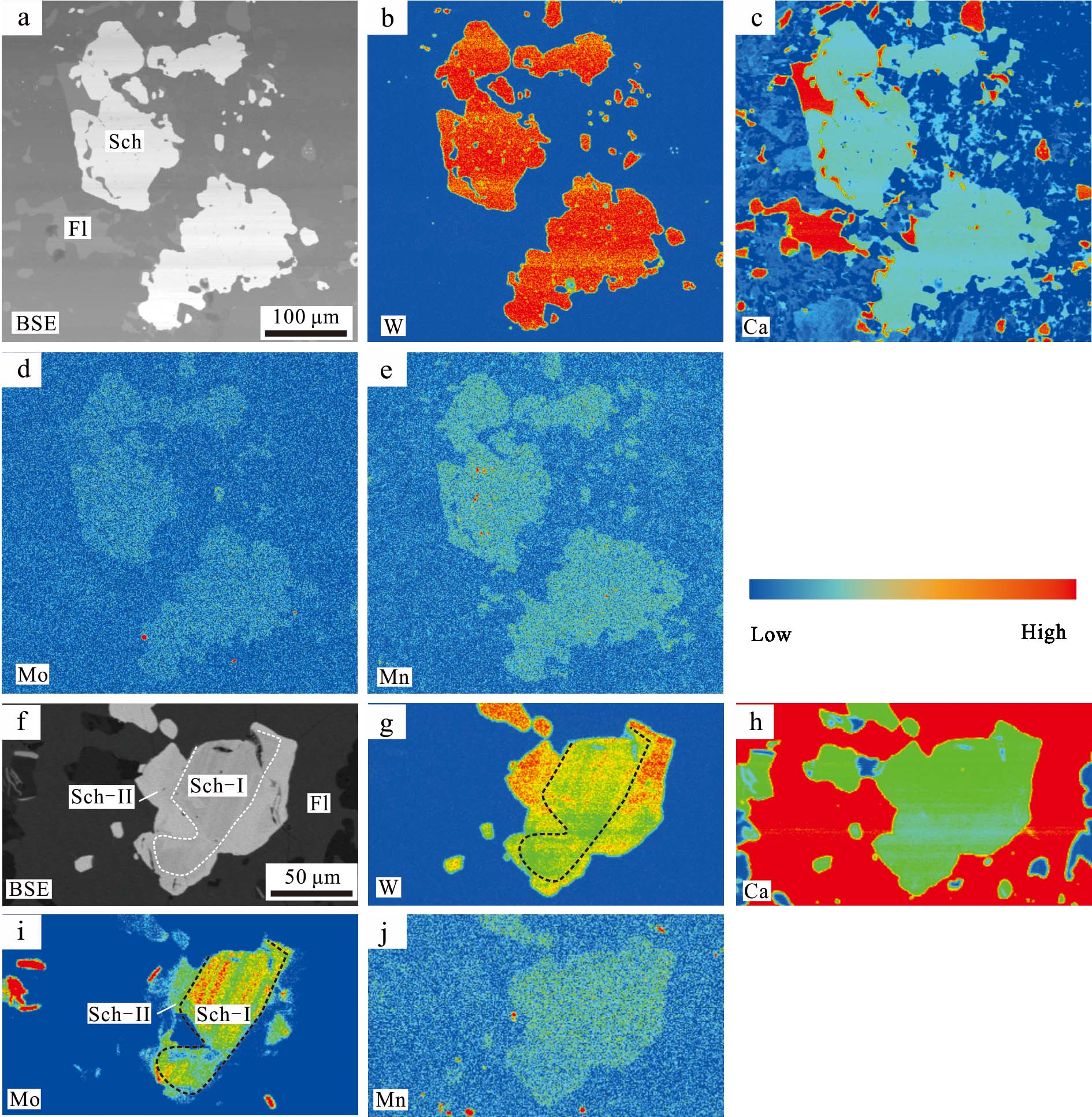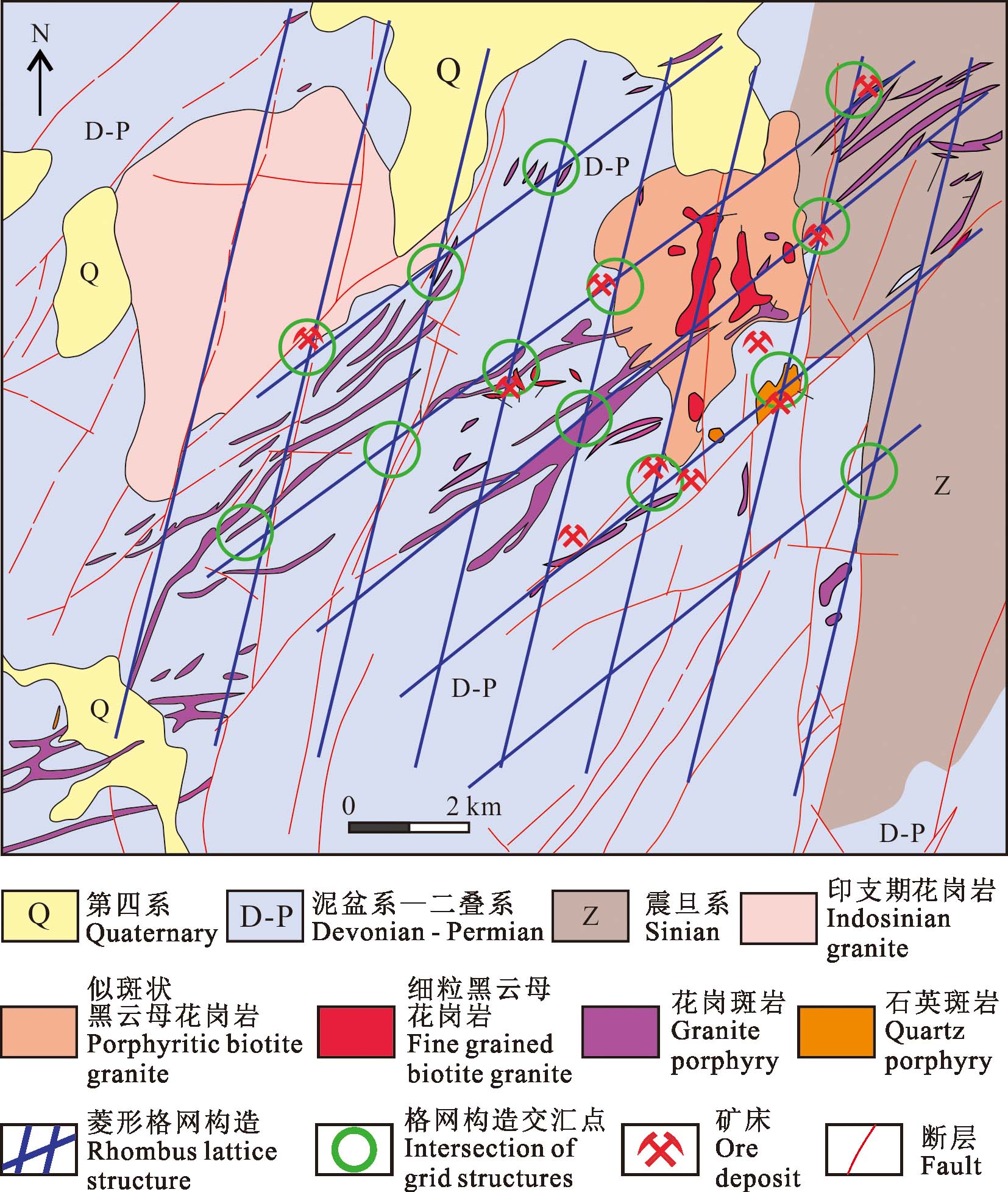-
云英岩型钨多金属矿是由高温岩浆气热作用形成的矿床,该类矿床属于岩浆热液过渡类型(林新多, 1999),在不同条件下呈现较为复杂的蚀变特征,但与钨锡成矿关系密切的蚀变过程主要为云英岩化(翟裕生等, 2011),因此,被称为云英岩型矿床(斯米尔诺夫, 1981)。肖惠良等(2012)对南岭东段钨矿床研究认为这类矿床经历结晶分异和分异-交代作用,可以在不同岩体和不同部位形成多样的矿化类型。这类矿床在文献中有多种表述, 如蚀变岩体型钨矿床(徐文光等, 1987;王宾海等, 2016)、花岗岩型钨矿床(肖惠良等, 2008; 2010; 2012)、岩体型钨矿床(林运淮, 1982;谭运金, 1983;朱祥培等, 2006;吴剑, 2018;蔡富成等, 2021;李胜苗等, 2021)、斑岩型钨矿床(谭运金, 1983;袁晶等, 2017),这些命名中从不同侧面反映了该类矿床的特征。这类矿床具有重要的经济价值,如著名的湘南柿竹园钨多金属矿床在花岗岩内发育块状云英岩(廖兴钰,2021),且在矽卡岩中叠加了脉状云英岩(毛景文等,1998),成为矿区重要的矿化类型。近10年的钨找矿勘查显示云英岩型钨多金属矿床是重要的突破类型,如在粤北红岭钨矿床,勘查发现了大型的云英岩型钨矿体(吴剑,2018)。
柿竹园是中国最为重要的超大型钨多金属矿床,自20世纪50年代发现以来,一直受到地质学者的关注,对该矿床地质及地球化学特征、花岗岩成因进行了详细的研究(毛景文等,1994; 1995; 1996; Mao et al., 1995;季克俭等,1998; Lu et al., 2003; Li et al., 2004; Chen et al., 2014;赵正等,2022)。该矿床经历了复杂的成矿过程,表现出矽卡岩型-云英岩型复合矿床的特征(王书凤等,1988;毛景文等,1995; Wu et al., 2023)。目前柿竹园钨多金属矿床的研究热点、矿产预测与勘查的重点主要围绕矽卡岩型矿床(成永生,2016;吴锟言,2023)。而对具有重要经济价值的云英岩型钨多金属矿的成矿规律及勘查前景缺乏深入的认识。本文在野外地质调查基础上,对矿田内云英岩型钨多金属矿化类型、空间分布及控制因素进行了系统分析,最后基于成矿规律,提出了云英岩型钨多金属矿的找矿靶区3处,供进一步勘查验证。
1区域地质及矿田地质1.1区域地质湘东南地区整体处于华夏陆块内,而又以茶陵-郴州-临武断裂带为界划分出2个构造单元(湖南省地质调查院,2017):北西侧为桂阳-宁远坳褶带,东南侧为炎陵-汝城冲断褶隆带。在成矿带归属上,湘东南地区属于传统南岭成矿带的中段,以钨锡矿并重为特点,区别于与南岭东段以钨矿为主,南岭西段以锡为主的特点(华仁民等, 2010; Zhao Z et al., 2018; 2021)。近20年来,随着北东向钦杭成矿带的识别和深化研究(郭春丽等,2013;周永章等,2017),目前人们认为湘南东地区构造位置上位于北东向钦杭成矿带与东西向南岭成矿带的叠合部位(图1),对其研究促进了区域成矿的认识。
湘南地区出露地层从南华系—第四系均有分布,其中以南华系—寒武系、泥盆系—三叠系尤为发育。南华系—寒武系以碎屑岩类、碳质板岩、硅质岩为主。泥盆系—中三叠统广泛出露,主要属滨海-浅海相碳酸盐岩沉积建造和海陆交互相的碎屑岩沉积。上三叠统—侏罗系属陆相含煤盆地建造。白垩系—第四系发育,属红色陆相裂陷盆地沉积。泥盆系—中三叠统碳酸盐岩和碎屑岩分布广泛,是区内主要的赋矿层位。湘南地区经历长期的地壳演化,不同时期形成了各自特色的褶皱-断裂等构造形变行迹。按构造形成时代可划分为加里东期、印支期、燕山期等期次。褶皱构造中,加里东期主要形成了分布在九嶷山地区的东西向褶皱,东江湖东部地区的东西向—北西西向的褶皱,印支期在耒阳-嘉禾-宜章地区发育一系列复杂的类侏罗山式褶皱群,在炎陵-汝城地区发育一系列隔槽式褶皱群(柏道远等,2006;湖南省地质调查院,2017)。湘南区域性断裂有2组:南北向断裂和北东向断裂,前者为印支期褶皱伴随的断裂,后者为茶陵-郴州-临武断裂为主的深大断裂。其中茶陵-郴州-临武断裂是湘南地区最重要的控岩、控矿断裂之一。湘南地区岩浆岩以花岗岩为主,加里东期、印支期、燕山期花岗岩均有发育,尤其以燕山期花岗岩最为强烈。燕山期花岗岩岩浆分异程度较高,岩石类型主要包括黑云母二长花岗岩、二云母花岗岩、花岗闪长岩等(弥佳茹,2016)。根据岩浆岩的岩石类型及成矿差异,可分为2类花岗岩:① 花岗质岩体,以千里山、骑田岭、黄沙坪、香花岭为代表,与W、Sn、Nb、Ta及REE等成矿关系密切;② 花岗闪长质岩体,以水口山、宝山、铜山岭等为代表,与Cu、Pb、Zn、Au等成矿关系密切(毛景文等,1995;华仁民等,2003;姚军明等,2005)。
1.2矿田地质概况(1) 地层。矿田内出露的地层主要为中、上泥盆统、下震旦统,其次为少量第四系(图2)。中、上泥盆统广泛分布于矿区中部,呈北北东向延伸,组成东坡-月枚复式向斜的槽部及两翼地层。中统为跳马涧组(D2t)砂页岩、砾岩和棋梓桥组(D2q)白云质灰岩,上统为佘田桥组(D3s)泥质条带灰岩、泥质灰岩和锡矿山组(D3x)白云质灰岩。其中佘田桥组是区内主要赋矿层位,又可分为4岩性段(D3s1、D3s2、D3s3、D3s4)。
(2) 构造。矿田内一级褶皱为东坡-月枚复式向斜,轴向为10°~15°,其东西侧发育产状外倾的高角度冲断层,与毗邻的五盖山背斜、西山背斜相隔,构成“对冲断陷式”复式向斜。发育二级褶皱6个,由东到西依次为:金狮岭向斜、古塘背斜、中山向斜、岔路口背斜、金船塘向斜、观音座莲背斜。区内断裂按走向和力学性质可以分为:南北向(包括北北东-北北西向)压性(或压扭性)断裂、北东向压扭性断裂、北西向(300°~330°)扭性断裂及东西向张性断裂4组。
(3) 岩浆岩。矿田内岩浆岩发育,主要有千里山复式花岗岩岩株、花岗斑岩脉及少量的辉绿玢岩脉(图2)。千里山复式岩体整体呈南北向,平面上北宽南窄,形似倒葫芦状,面积近10 km2。关于千里山复式岩体的期次划分存在不同的划分方案(王昌烈等,1987;徐文光等,1987;王书凤等,1988;毛景文等,1998;陈荣华等,2015;郭春丽等,2015)。该复式岩体主要发育3期(图2),第一期由边缘相(γ52-1a)和中心相(γ52-1b)组成,其中边缘相由细粒、中细粒斑状黑云母花岗岩组成,分布于千里山岩体的周缘,中心相由中-粗粒黑云母花岗岩组成,分布于岩体中心位置;第二期(γ52-2)由细粒斑状黑云母花岗岩组成,主要分布于岩体中南部和玛瑙山地段;第三期(γ52-3)由细粒花岗岩组成,出露规模小,分布于岩体南段边缘相和岩体北部局部地段。郭春丽等(2015)采用锆石Cameca U-Pb定年测得第一期花岗岩年龄为152.3~154.5 Ma,第二阶段年龄151.6~152.4 Ma,花岗斑岩年龄为151.7~152.1 Ma,因此,不同期次岩体锆石年代学显示花岗岩形成时代相近。前人对千里山复式花岗岩体开展了详细的岩相学、地球化学研究,认为其属于A2型花岗岩,由古元古代变质基底部分熔融形成(Jiang et al., 2009)。
图1湘南地区地质矿产简图(据Peng et al., 2006)
Fig. 1 Simplified geological and ore deposits distribution map of the southern Hunan (after Peng et al., 2006)
图2柿竹园矿田地质简图(据陈荣华等,2015)
Fig. 2 Simplified geological map of the Shizhuyuan orefield (after Chen et al., 2015)
柿竹园矿田内已查明的矿种主要有钨、锡、钼、铋、铜、铅、锌等有色金属矿产,铁、锰等黑色金属次之。钨锡钼铋矿床主要分布在千里山花岗岩体的接触带,除规模巨大的柿竹园矿床外,还有野鸡尾、岔路口、水湖里、天鹅塘等大、中型矿床;在离主体花岗岩较远及花岗斑岩两侧的碳酸盐岩中,有中温热液铅锌矿床分布,如金船塘、蛇形坪、横山岭、金狮岭、东坡山、野鸡尾等中、小型矿床;在碎屑岩中有裂隙充填型锡铅锌矿,如红旗岭、南风坳、枞树板等,规模达中至大型;铁锰矿主要分布于柿竹园矿田西部的玛瑙山、玉皇庙、枫树下一带,矿床规模属中、小型。
2云英岩型矿化样式及空间分布2.1云英岩型矿化样式柿竹园矿田内的云英岩体与千里山复式岩体的第一和第二期黑云母花岗岩成因关系密切,根据云英岩的原岩的岩性差异、矿化样式及与矽卡岩型的关系,矿田内发育4类云英岩型矿体。
(1) 产于第一期边缘相中细粒斑状黑云母花岗岩的顶部与边部的云英岩型矿体。该类云英岩型矿体分布于千里山岩体南端的大吉岭矿床(图3)、岩体东南的柿竹园矿床和北部的妹子垄矿床。大吉岭云英岩体位于千里山岩体南端,南部云英岩化面积较大(王昌烈等,1987),对该区南端西侧开展了少量的工作,发现该区矿化云英岩体规模长超过500 m,宽50~100 m不等,民企对浅部石英脉型密集的黑钨矿脉进行了小规模开采。该区发育面状云英岩,包含石英白云母黄玉云英岩、石英白云母云英岩和黄玉石英萤石云英岩,也发育脉状云英岩。从目前产出见到的矿化蚀变特点,可见脉状和网脉状构造和块状构造(图4a~c),荧光灯下可见白钨矿和萤石(图4d~e)。目前控制的云英岩平均品位WO3为0.26%。具有重要的经济价值。
柿竹园钨锡钼铋矿床矿体产于细-中粗粒黑云母二长花岗岩与棋梓桥组白云质灰岩和佘田桥组泥质条带状灰岩夹泥灰岩的接触带(徐文光等, 1987)。根据矿体产出部位、矿化特点和矿石类型,以花岗岩为中心,向外依次为Ⅰ、Ⅱ、Ⅲ、Ⅳ四个矿带(徐文光等, 1987),各矿带之间界线不明显,呈渐变过渡关系,各矿带之间有时有穿插和包含现象(图5),各带矿石特征见表1。其中Ⅳ矿带为产于花岗岩内接触带的云英岩或者云英岩化花岗岩中的钨锡钼铋矿带,矿体呈透镜状、扁豆状,矿化较为均匀。该带西部以白钨矿为主,伴生辉钼矿、辉铋矿,东部锡矿化较强,一般情况下部钨为主,上部以锡为主。该类云英岩也被称为近端块状云英岩。
图3柿竹园矿田大吉岭矿床地质图(a)和剖面图(b)(据徐文光等,1987)
Fig. 3 Geological map (a) and section (b) of the Dajiling deposit in the Shizhuyuan orefield (after Xu et al., 1987)
图4柿竹园矿田大吉岭矿区典型蚀变标本
a. 似斑状黑云母花岗岩发育脉状绿泥石化;b. 网脉状云英岩化;c. 块状云英岩;d. 荧光灯下云英岩中萤石和白钨矿;e. 荧光灯下云英岩中白钨矿
Fig. 4 Typical alteration rock of the Dajiling deposit in the Shizhuyuan orefield a. Chlorite vein developed in porphyroidal biotite granite; b. Network greisen; c. Massive greisen; d. Fluorite and scheelite in greisen under fluorescent lamp; e. Scheelite in greisen under fluorescent lamp
(2) 产于石英斑岩中的云英岩型矿体。在千里山岩体东南侧产有众多的石英斑岩株,发育云英岩型矿化的有野鸡尾30号矿体(图5)和柿竹园Ⅳ2-1号矿体局部地段。该类石英斑岩被认为是第一期岩体的浅成侵入体(徐文光等,1987)。野鸡尾矿床圈出30号、31号和32号3个矿体,其中30号矿体产于石英斑岩体内(图5),为岩体内细脉浸染状矿化,矿体云英岩化强烈,被认为是斑岩型矿体或云英岩型矿体(苏咏梅, 2008)。矿体呈不规则的筒柱状产出,倾向北西,倾角陡立。矿体东西向长100~300 m,南北向长50~115 m,延伸近400 m(谭若发等, 2009)。矿体以锡为主,伴生钨、铜等,w(Sn)平均为0.30%,w(Cu)为0.15%,w(WO3)为0.13%(刘盛镇等, 1986)。矿体在地表见有出露,出露标高为900~700 m。矿体在755 m及710 m中段膨大,向上、向下逐渐减小(刘盛镇等, 1986)。
(3) 产于第二期中粗粒黑云母花岗岩顶部花岗岩的云英岩型矿体。该类矿化主要产于玛瑙山矿床(图7)。
玛瑙山云英岩型钨多金属矿体分布于玛瑙山至水湖里北西一带岩体隆起部位,为南北长约1200 m、东西宽约800 m、厚约200 m的蚀变矿化体(陈志永等, 2015)。矿体厚大,产状平缓,为钨锡共生矿体,共圈定6个矿体,其中主矿体5个(①、②、⑥、⑦、⑨号矿体)。最大的①号矿体走向北西340°,倾向南西西250°,倾角5°~15°(图7),已控制走向长655 m,最大倾斜延伸552 m,矿体平均厚度8.79 m。以低品位钨矿为主,WO3平均品位0.146%,Sn平均品位0.347%。矿石矿物有锡石、黑钨矿、辉钼矿、辉铋矿等,脉石矿物有石英、云母、萤石等。
图5柿竹园钨多金属矿床490 m中段地质图(a)和IX线剖面图(b)(据陈荣华等,2015编制)
Fig. 5 Geologic level plan at 490 m elevation(a) and IX section (b) of the Shizhuyuan tungsten polymetallic deposit (modified Chen et al., 2015)
图6柿竹园矿田野鸡尾矿床地质图(刘盛镇等, 1986)
Fig. 6 Geological map of the Yejiwei deposit in the Shizhuyuan orefield (after Liu et al., 1986)
(4) 网脉状云英岩叠加矽卡岩形成的矽卡岩型-云英岩复合型矿体。该类矿体主要产于柿竹园矿床Ⅲ号矿带(图6a、b)和柴山钨多金属矿床(图8a~c)。
表1柿竹园钨多金属矿床矿石类型及矿物组合表(据徐文光等,1987)
Table 1 Ore types and mineral assemblages of the Shizhuyuan tungsten polymetallic deposit (after Xu et al., 1987)
矿带
矿石类型
主要矿石矿物
次要矿石矿物
主要脉石矿物
次要脉石矿物
Ⅰ
网脉状大理岩型锡(铍)矿石
锡石
黝锡矿、木锡矿、闪锌矿、方铅矿、磁黄铁矿、黄铁矿、黄铜矿、毒砂、日光榴石等
方解石、萤石
绢云母、绿泥石、石英、电气石、斜长石、钾长石、石榴子石、符山石、绿帘石等
Ⅱ
矽卡岩型钨铋矿石
白钨矿、辉铋矿
辉钼矿、黑钨矿、锡石、磁黄铁矿、黄铁矿、黄铜矿、磁铁矿、自然铋、闪锌矿、辉铅铋矿等
石榴子石、透辉石、符山石、萤石
绢云母、绿泥石、绿帘石、富铁钠闪石、长石、石英、硅灰石、方解石等
Ⅲ
云英岩网脉-矽卡岩复合型钨锡铋钼矿石
白钨矿、黑钨矿、辉钼矿、辉铋矿、锡石
磁铁矿、磁黄铁矿、黄铁矿、闪锌矿、自然铋、日光榴石等
石榴子石、透辉石、角闪石、长石、石英、萤石等
云母、帘石、黄玉、方解石、电气石、绿柱石、塔菲石、刚玉、符山石、阳起石等
Ⅳ
云英岩型钨锡铋钼
矿石
黑钨矿、白钨矿、辉铋矿、辉钼矿、锡石
磁铁矿、磁黄铁矿、黄铁矿、黄铜矿、自然铋、独居石、含铍矿物等
石英、黄玉、白云母、萤石、黑鳞云母等
钾长石、斜长石、绿泥石、电气
石等
图7玛瑙山矿床21线剖面图(陈志永等, 2015)
Fig. 7 Geologic section at exploration line No. 21 through the Manaoshan deposit (after Chen et al., 2015)
柿竹园钨多金属矿床Ⅲ矿带为产于正接触带下部紧贴花岗岩一侧,为云英岩网脉叠加矽卡岩形成的钨锡铋钼矿带(徐文光等, 1987),矿带内矿物和元素组合复杂,有用矿物有白钨矿、黑钨矿、辉铋矿、辉钼矿及锡石等,呈浸染状、细脉浸染状分布于矽卡岩及云英岩网脉中。该类云英岩称为远端脉状云英岩,矿体呈大透镜状,厚度大,矿化强,且连续温度,品位高,是矿床富矿体产出部位。
柴山钨锡钼铋矿床与柿竹园钨锡钼铋矿床成矿条件及矿化特征类似,产于千里山岩体南端外接触带矽卡岩中(图8a~c),围岩为泥盆系上统佘田桥组泥质条带灰岩。勘查工作圈出钨钼铋锡多金属矿体19个,其中1号为主矿体,1-2、1-3为次要矿体(陈荣华等,2015)。1号钨钼铋锡多金属矿体,受接触带构造控制,呈似层状、透镜状产出(图8b、c),形态复杂,具分支复合现象,矿体产状多变。矿体走向北东30°~ 45°,倾向南东,倾角15°~40°。矿体长500余米,宽20~700 m,厚度15~172 m。主岩体在350 m中段平面上出露面积很大,矿体围绕岩体四周分布。矿体呈北西厚大,南东侧薄并在中部因岩体侵入而切断,厚度最大处达206 m。矿体在矽卡岩中矿化较为连续,平均品位:WO3 0.217%;Mo 0.056%;Bi 0.057%;Sn 0.084%。矽卡岩矿物成分复杂,主要为透辉石、石榴子石、硅灰石、符山石及透闪石。矽卡岩被后期网脉状云英岩叠加(图9a~c),形成矽卡岩-云英岩复合型富矿体。
图8柴山钨多金属矿床450 m中段平面图(a)、70线剖面(b)和AB纵剖面图(c)(据陈荣华等,2015修改)
Fig. 8 Geologic level plan at 450 m elevation (a), section at exploration line 70 (b) and AB section (c) of the Chaishan W-polymetallic deposit (modified after Chen et al., 2015)
2.2云英岩型矿体与矽卡岩型矿体及花岗岩的关系云英岩体矿化与花岗岩关系密切,从柿竹园矿田发育的3期岩浆岩,前两期与成矿关系密切,发育规模不等的矽卡岩和云英岩型矿体,且不同期花岗岩形成的云英岩体与矽卡岩型矿体存在明显的差异。与第一期斑状黑云母花岗岩有关的云英岩,主要产于南部花岗岩的顶部(大吉岭矿区)、北部(妹子垄矿区),该期的云英岩可与矽卡岩型钨多金属矿共生,但不产生网脉状云英岩。因此,导致北部妹子垄矿区仅有低品位的钨矿体。而该区花岗岩可形成矽卡岩型铁锡铋矿床(如西侧和西南接触带)。第一期花岗岩的浅成相石英斑岩可发育云英岩型矿体(野鸡尾30号矿体),也可以发育矽卡岩型锡铜矿体(野鸡尾31号和32号矿体),但该处矽卡岩型未出现叠加网脉状云英岩。因此,第一期岩浆岩活动可形成块状云英岩,但难以形成脉状云英岩,可能是由于成矿的深度总体较深的缘故。
图9柴山矿床矽卡岩-网脉状云英岩复合型矿石照片
a. 大理岩中石榴子石-透辉石与云英岩脉复合脉;b. 石榴子石透辉石矽卡岩中叠加网脉状云英岩脉,脉体中发育辉钼矿矿化;c. 石榴子石矽卡岩发育网脉状云英岩脉,脉体边部发育辉钼矿
Mb—大理岩;Gr—云英岩脉;SK—矽卡岩
Fig. 9 Photographs of typical skarn-veinlet greisen composite ores from the Chaishan deposit a. Garnet-diopside-greisen complex vein in marble; b. Garnet-diopside skarn superimposed by network greisen, in which molybdenum mineralization occurs; c. Garnet skarn superimposed by network greisen, molybdenum occurs in the vein edgeMb—Marble; Gr—Greisen vein; SK—Skarn
第二期细粒黑云母花岗岩发育2类云英岩:岩体顶端的块状云英岩和岩体外接触带的脉状云英岩。前者在玛瑙山矿床发育,后者叠加在早期矽卡岩型钨锡矿体上,从而形成高品位的钨锡矿体,在柿竹园钨多金属矿床Ⅲ号矿带和柴山钨多金属矿床发育。因此,第二期细粒黑云母花岗岩是导致柿竹园矿田钨锡多金属富矿体形成的重要因素。
表2柴山矽卡岩型和云英岩型矿体中白钨矿电子探针测试数据(w(B)/%)
Table 2 Electron probe data of scheelite in skarn-type and greisen-type orebodies of the Chaishan deposit (w(B)/%)
测点
WO3
MnO
MoO3
CaO
总和
矽卡岩中的白钨矿
csd8-1
79.73
0.04
0.71
19.50
99.98
csd8-2
80.44
0
0.09
20.15
100.68
csd8-3
80.45
0.04
0.09
20.00
100.58
csd8-4
81.36
0.02
0.07
19.54
100.99
csd8-5
79.44
0.01
0.26
20.13
99.84
csd8-6
76.33
0.04
3.97
20.45
100.79
csd8-7
77.68
0
0.93
21.80
100.41
csd8-8
73.34
0.02
5.62
21.01
99.99
csd8-9
80.93
0.03
1.89
17.98
100.83
csd8-10
79.08
0.02
1.84
18.51
99.45
云英岩中的白钨矿
csd13-1
78.89
0
0.05
21.09
100.03
csd13-2
75.10
0
4.95
20.48
100.53
csd13-3
66.10
0
11.89
22.21
100.20
csd13-4
67.67
0.05
11.43
20.10
99.25
csd13-5
67.93
0
9.42
22.56
99.91
csd13-6
68.72
0.05
9.53
22.13
100.43
csd13-7
80.59
0
0.66
19.72
100.97
csd13-8
76.33
0.01
2.89
20.01
99.24
3云英岩型矿体与矽卡岩型矿体中白 钨矿矿物学差异为揭示云英岩型矿体和矽卡岩型矿体中的白钨矿的差异,开展了两类白钨矿的显微观察、矿物电子探针分析及元素面扫描。
矽卡岩中的白钨矿与石榴石共生,颗粒较粗(图10a),对该类白钨矿(样号:csd8)电子探针分析显示Mo含量较低,为低于检测限至0.04%(表2),元素面扫描(图10b~e)显示元素较为均匀,无环带现象。云英岩呈脉状,白钨矿与辉钼矿、萤石、斜长石共生。样品(样号csd13)背散色图像显示白钨矿具有分带特征(图10f),电子探针数据显示该类白钨矿w(Mo)为0.05%~11.89%,根据显微环带特征可分为2个世代(Sch-Ⅰ、Sch-Ⅱ),Sch-Ⅰ为白钨矿集合体的核部,为早世代白钨矿,在BSE图像中呈现暗色,电子探针数据显示其w(MoO3)超过3%(表2),元素面扫描(图10g~j)显示其富Mo贫W,而Sch-Ⅱ为集合体的外部,在BSE图像中呈亮色,其w(MoO3)低于3%,元素分布具有富W相对贫Mo的特点。云英岩型白钨矿相对富Mo特点与该区白钨矿与大量辉钼矿伴生的特征显示晚期云英岩成矿流体中富W、Mo。此外,Mo-W替代主要发生在氧化环境下,白钨矿较高MoO3含量表明其形成于较高的f(O2)环境(Zhao W et al., 2018; Wu et al., 2023)。矽卡岩和云英岩中白钨矿Mo元素的差异可能暗示云英岩型钨成矿具有相对氧化状态。
图10柴山矿床矽卡岩(a~e)和云英岩(f~j)中白钨矿背散色图像和X射线元素扫面图a. 矽卡岩中白钨矿的背散射图像;b~e. 矽卡岩中白钨矿W、Ca、Mo、Mn元素面扫图;f. 云英岩中的背散射图像;g~j.云英岩中白钨矿W、Ca、Mo、Mn元素扫描图Sch—白钨矿;Fl—萤石
Fig.10 Back-scattered images and X-ray elemental scanning images of scheelite in skarn (a~e) and greisen (f~j) from the Chaishan deposit a. Backscattered images of scheelite in skarn; b~e. W, Ca, Mo, Mn X-ray elemental scanning images of scheelite in skarn; f. Backscattered images of scheelite greisen; g~j. W, Ca, Mo, Mn X-ray elemental scanning images of scheelite in greisen Sch—Scheelite; Fl—Fluorite
4云英岩型矿体控矿特征及规律4.1岩浆岩前锋控矿规律柿竹园钨多金属矿床为岩浆热液型矿床,其形成受控于花岗岩体,而岩浆热液的前锋是钨锡矿床成矿的有利部位。对柿竹园矿田岩浆侵位与钨锡矿化关系分析显示在矿田尺度和矿床尺度上均存在岩浆岩前锋控矿的特征。
在矿田尺度上,首先分析整个矿田岩体的侵位局势。重力资料显示千里山岩体的重力异常中心位于北东部位(宋才见等,2020),暗示岩体深部向北东倾伏。千里山岩体岩相特征显示北部粒度较南部粗,相带具北宽南窄的特点,这些特点均指示岩浆岩由北东深部向南西浅部侵位,岩体的南段为岩浆热液的前锋,目前所见到的大型-超大型钨锡铅锌矿床均发育于南段。在矿床尺度上,大多数矿床均产在岩体的岩突部位,尤其以柴山钨多金属矿床、玛瑙山矿床及红旗岭矿床最为典型,前人构建的成矿模型也指示岩突成矿的特征(Zhao W et al., 2018)。因此,目前柿竹园矿田内岩浆岩前锋控矿规律特征明显,是区内靶区选择的重要准则。
4.2菱形格状控矿规律前述岩浆前锋控矿规律显示矿化受岩突控制,在该区开展成矿预测要综合考虑岩浆-构造的具体的空间展布。从目前柿竹园及邻区岩浆岩定位与断裂构造关系,认为区内发育菱形格状构造。
区内岩浆岩岩突-矿化空间定位受南北向褶皱断裂与北东向断裂控制(图11),两组构造均具有一定的等距性,构造的间距大约1 km,形成菱形格状构造控制。构造的交汇点即是构造薄弱位置,是岩浆岩-矿体定位的有利位置。这一规律的厘定对区内的矿产勘查部署具有重要的意义。当然不是所有的构造交汇点均有岩体和矿床的产出,受具体交汇点的地质情况所控制。
5云英岩型钨多金属矿成矿预测5.1云英岩型钨多金属矿找矿标志云英岩型钨多金属矿在华南地区分布广泛,由于该类与花岗岩型、斑岩型存在类似或过渡特征,在统计云英岩型钨矿床在总资源占比中可能低估了其储量(盛继福等,2018)。综合中国云英岩型钨矿床的成矿规律及本次柿竹园矿田云英岩型矿体的发育情况,云英岩型钨多金属找矿标志主要有以下6个标志:
(1) 岩浆岩性质。成矿花岗岩为与壳源改造型花岗岩有关,岩浆的演化程度、挥发分组分的含量等对云英型矿体成矿具有重要的指示;
(2) 控矿构造标志。云英岩体产于岩体的顶部或接触带,因此岩突部位是云英岩矿体发育的有利地段。而岩突的定位可能受到浅部多组构造交叉部位的影响,如菱形格状断裂的交叉点即是一种良好的构造部位;
(3) 围岩蚀变标志。围岩蚀变主要有钾化、钠长石化、云英岩化、硅化、绿泥石化等。其中云英岩化与钨锡矿化直接相关,在云英岩型钨多金属矿带上部发育强烈的云英岩化,而下部云英岩化减弱(盛继福等,2018);
(4) 地球化学标志。由于岩体内发育云英岩型矿化,可在地表形成W、Sn、Bi、Mo、Cu、Pb、Zn、多金属组合异常,如柿竹园矿田内已圈出大吉岭和妹子垄两个异常(郭海等,2011),其中大吉岭地球化学异常即发育较大规模的云英岩型矿体;
(5) 地貌标志。由于岩体顶部发育云英岩化及石英脉等,如云英岩出露地表,因抗风化能力较强,形成陡峻的地貌,如湘南地区香花岭矿田的癞子岭、尖峰岭等出露地表的云英岩型矿体均形成陡峻的地貌。因此,地貌标志是地表云英岩型钨锡矿体勘查的重要标志;
(6) 矿化标志。云英岩型矿化与其他矿化类型伴生产出,因此,浅部的脉状钨锡矿和矽卡岩型钨锡矿对指示深部的云英岩型矿化具有指示意义。
5.2找矿靶区根据矿田控矿因素展布特征及云英岩型钨多金属矿的矿化特征,本次研究提出柿竹园矿田以下3处云英岩型找矿靶区,可供进一步勘查验证。
(1) 大吉岭云英岩型钨多金属矿找矿靶区。
靶区位置:千里山岩体南端,X=2 846 700~2 848 000,Y=38 415 000~38 415 900,面积为1.17 km2。靶区预测依据:①成矿地质条件上,从岩浆侵位角度,大吉岭找矿靶区位于千里山岩体最南端,是岩浆-热液的前锋位置,处于有利的成矿位置;②物化探异常,地表发育大吉岭钨锡钼铋多金属综合异常,组合元素多,以W、Sn、Bi、Pb、Zn、Mn为主,异常浓度高,有梯度变化,面积大浓度中心在南部(徐文光等,1987);③矿化特征:目前已对云英岩体进行了局部勘查,显示W、Sn、Mo、Bi达到工业品位,形成了低品位大规模矿体。该区工作程度低,仅20世纪80年代开展少量工作,部分捡块化学样品测试具有较高的Li;④地貌标志:该区云英岩呈陡峻的地形(图12),可能是由于岩体发生云英岩化,难以风化所致,区内云英岩型矿体的勘查应注意地貌标志。总之,该靶区是柿竹园矿田范围内重要的W-Sn-Mo-Bi-Li找矿靶区。
图11柿竹园矿田菱形格状控岩控矿构造示意图
Fig. 11 Sketch map of rhombus lattice structure controlling intrusion and orebodies in the Shizhuyuan orefield
(2) 柿竹园深部云英岩型钨多金属矿找矿靶区。
靶区位置:位于千里山岩体的东南侧X=2 848 000~2 849 500;Y=38 416 000~38 416 500;面积2.25 km2。靶区预测依据:①矿化垂向分带规律,深部具有云英型钨多金属矿找矿前景。矿区已发育柿竹园超大型钨锡钼铋矿床,上部已见矽卡岩型+云英岩型矿体,同时发现了云英岩出现于斑状黑云母花岗岩体隆起上部,呈冠状和似层状(图5)。根据南岭地区钨锡铌钽矿床的成矿规律,花岗岩体由下到上形成了钾长石化花岗岩、钠长石化花岗岩、云英岩化花岗岩、似伟晶岩的分带规律。柿竹园矿床已形成超大型钨锡钼铋矿床,按矿化分带规律,深部具备云英岩型铌钽锂铷矿床的勘查前景;②矿化特征:由于20世纪五六十年代勘探到主要的矽卡岩型矿体,钻孔进入花岗岩不深后即终孔,对深部岩体内矿化情况关注较少。矿区深部局部揭露云英型钨锡矿体,部分地段尚未完全控制,例如前人在490 m中段分析的花岗岩中W含量部分达到工业品位(1370×10-6~2038×10-6;毛景文等, 1998)。前人地球化学化学测试数据显示的花岗岩中Nb(60×10-6~ 80×10-6)、Ta(10×10-6~ 20×10-6)、Rb(700×10-6~ 1000×10-6)等含量较高,局部达到边界品位。因此,深部具有云英型钨多金属矿找矿前景。
图12柿竹园矿田大吉岭靶区地形地貌特征 a. 云英岩体东侧地貌;b. 云英岩体南侧地貌;c. 云英岩体南西地貌
Fig. 12 Topographic and geomorphologic characteristics of the Dajiling target in the Shizhuyuan orefield a. The landform of the East side of the greisen; b. The landform of the South side of the greisen; c. The landform of the Southwest side of the greisen
(3) 柴山云英岩型钨多金属矿找矿靶区。
靶区位置:该区位于千里山岩体的南端,X=2 846 000~2 847 100;Y=38 415 300~38 416 100,面积0.88 km2。预测依据:①矿化垂向分带规律:区内成矿条件与柿竹园深部类似,岩体为云英岩化细粒斑状黑云母花岗岩,东南端发育的次级岩突形成了柴山钨多金属矿床,矽卡岩型中同样叠加了网脉状云英岩,形成了大规模的复合型钨多金属矿体。该区勘探钨多金属矿时主要以矽卡岩型为主,钻孔进入花岗岩后即终孔,对花岗岩体内的云英型钨多金属矿和钠长岩化花岗岩型稀有金属矿探索较少;②矿化信息:接替资源勘查项目实施的钻孔ZK60A01孔见到2.23 m处w(WO3)为0.109%的云英型钨矿化体,其赋存标高在-150 m,而在岩体西南的坑内钻GK4001钻孔中,取样分析的w(W)为1000×10-6~ 1490×10-6之间(表3),折合成w(WO3)为0.13%~0.19%,比同一钻孔中的矽卡岩型钨矿化体含量还高,该处云英岩化钨矿化体赋存标高为250 m。因此,该地段岩体顶部具有云英型钨多金属矿找矿前景。此外,该靶区深部揭露的花岗岩Nb、Ta、Rb含量较高,具有形成蚀变花岗岩中的稀有金属矿的潜力。
表3柴山矿床GK4001钻孔矿化花岗岩稀有金属及相关元素含量(w(B)/10-6,据成永生,2016)
Table 3 Contents of rare metals and related elements of mineralized granite in GK4001 borehole from the Chaishandeposit (w(B)/10-6, after Cheng et al., 2016)
元素
GK4001-01
GK4001-02
GK4001-03
GK4001-04
GK4001-05
GK4001-06
GK4001-07
GK4001-08
GK4001-09
CK4001-10
Li
59.40
117.00
27.00
23.00
40.90
29.20
9.85
13.40
15.50
20.80
Be
23.02
20.70
38.32
22.68
15.64
3205
11.23
1200
14.76
10.75
Rb
725.00
713.00
531.00
797.00
736.00
782.00
652.00
668.00
842.00
795.00
Zr
133.00
110.00
106.00
109.00
128.00
112.00
92.30
123.00
106.00
79.20
Nb
65.60
64.66
65.60
67.37
61.19
75.77
50.34
74.66
50.17
52.37
Hf
7.12
6.28
6.68
6.57
6.94
6.04
5.17
7.31
5.96
4.91
W
999.00
1170.00
1090.00
1170.00
1300.00
1300.00
1280.00
1040.00
1490.00
1200.00
U
44.00
41.40
43.40
48.90
48.40
43.50
35.10
38.30
32.10
38.80
Th
56.50
57.70
59.10
63.60
68.40
59.10
47.30
67.00
43.10
52.60
6结 论(1) 云英岩型钨多金属矿是柿竹园矿田的重要矿化类型,矿田内第一、二期黑云母花岗岩发育4类云英岩型钨多金属矿体:第一期边缘相中细粒斑状黑云母花岗岩中的云英型矿体和石英斑岩中的云英岩型矿体;第二期细粒斑状黑云母花岗岩中的云英岩型矿体和矽卡岩-网脉状云英岩复合型矿体。
(2) 柿竹园矿田矿化格局显示云英岩型矿化受矿田和矿床尺度的花岗岩体侵位前缘控制,矿田尺度表现为岩体由北东深部向南西浅部侵位,千里山岩体南部为岩体侵位的前缘,为矿田尺度的矿化富集区。矿床尺度表现为云英岩体的定位受控于花岗岩岩突的控制。此外,矿田菱形格状构造对柿竹园矿田内岩突的产出位置具有重要的控制作用。
(3) 结合矿田控矿构造格局,提出了大吉岭、柿竹园和柴山深部为云英岩型矿体进一步勘查的靶区。
致 谢 本文野外工作得到了湖南柿竹园有色金属有限责任公司领导及生产部、技术中心技术人员的支持,得到湖南省地质调查所陈必河教授级高工的指导。
-
参考文献
Bai D Y, Chen J C, Meng D B, Wang X H, Ma T Q, Zhang X Y and Chen B H. 2006. Forming mechanism of Indosinian trough-like folds in Yanling Region, Hunan[J]. Journal of Earth Sciences and Environment, 28(4): 10-14(in Chinese with English abstract).
Cai F C, Qin J H, Qin J N, Jiang B G and Zhu C S. 2021. Geochemical characteristics and LA-ICP-MS zircon U-Pb dating of ore-bearing granite of Chuankou intrusion-related tungsten deposit, Hunan Province[J]. Geology in China, 48(4): 1212-1224(in Chinese with English abstract).
Chen B, Ma X H and Wang Z Q. 2014. Origin of the fluorine-rich highly differentiated granites from the Qianlishan composite plutons (South China) and implications for polymetallic mineralization[J]. Journal of Asian Earth Sciences, 93: 301-314.
Chen R H and Liu Y X. 2015. Ore resources verification report of the Shizhuyuan tungsten polymetallic deposit in Chenzhou, Hunan Province[R]. Chenzhou, Hunan Province: South Hunan Institute of Geological Exploration. 42-123(in Chinese).
Chen Z Y, Huang J J, Wu L and Huang F F. 2007. Preliminary study on the geological characteristics and metallogenic mode of tungsten-tin greisen mineralization of the Manaoshan deposit in Chenzhou City[A]. Dai T G. Advanced progress of Hunan geoscience[C]. . Changsha: Hunan Map Publishing House. 195-200(in Chinese).
Cheng Y S. 2016. Metallogenic regularity and deep exploration of super-large tungsten-polymetallic deposit in the Shizhuyuan ore clusters in South Hunan[M]. Beijing: Geological Publishing House. 58-64(in Chinese).
Geology Survey Institute of Hunan Province. 2017. Regional geology of China·Hunan Province[M]. Beijing: Geological Publishing House. 913-941(in Chinese with English abstract).
Guo C L, Wang R C, Yuan S D, Wu S H and Yin B. 2015. Geochronological and geochemical constraints on the petrogenesis and geodynamic setting of the Qianlishan granitic pluton, Southeast China[J]. Mineralogy and Petrology, 109: 253-282.
Guo C L, Xu Y M, Lou F S and Zheng J H. 2013. A comparative study of the Middle Jurassic granodiorite related to Cu andthe Late Jurassic granites related to Sn in the Qin-Hang metallogenicbelt and a tentative discussion on their tectonic dynamic setting[J]. Acta Petrologica et Mineralogica, 32(4): 463-484(in Chinese with English abstract).
Guo C L, Yuan S D, Wu S H, Zheng J H, Liu X F and Yin B. 2015. Geology of the Shizhuyuan W-Sn-Mo-Bi-polymetallic deposit and adjacent areas in Hunan[M]. Beijing: Geological Publishing House. 25-60(in Chinese).
Guo H, Zhang G H, Lei Z Y, Qin Y Y and Zhou J H. 2011. Characteristics of geophysical and geochemical anomalies in the Dongpo lead-zinc deposit of Hunan Province and their role in ore-prospecting work[J]. Geophysical&Geochemical Exploration, 35(2): 192-197+202(in Chinese with English abstract).
Hua R M, Chen P R, Zhang W L, Liu X D, Lu J J, Lin J F, Yao J M, Qi H W, Zhang Z S and Gu S Y. 2003. Mesozoic and Cenozoic granite-related metallogenic system of South China[J]. Science in China (Series D: Earth Sciences), 33(4): 335-343 (in Chinese).
Hua R M, Li G L, Zhang W L, Hu D Q, Chen P R, Chen W F and Wang X D. 2010. A tentative discussion on differences between large-scale tungsten and tin mineralizations in South China[J]. Mineral Deposits, 29(1): 9-23(in Chinese with English abstract).
Ji K J and Guo X S. 1998. Water source of hydrothermal of the Shizhuyuan tungsten polymetallic deposit[J]. Mineral Deposits, 17(S1): 1047-1050(in Chinese).
Jiang Y H, Jiang S Y, Dai B Z, Liao S Y, Zhao K D and Ling H F. 2009. Middle to Late Jurassic felsic and mafic magmatism in southern Hunan Province, Southeast China: Implications for a continental arc to rifting[J]. Lithos, 107: 185-204.
Li H P, Luo L, Fan L J and Chen J. 2015. Mineralization features and prospecting indications for the “Basement-typed” tungsten deposit in Yudu-Ganxian ore-concentrated area[J]. China Tungsten Industry, 30(4): 7-14(in Chinese with English abstract).
Li S M, Tian L, Du Y, Zou Y, Fan H and Zhang J. 2021. Geological characteristics and prospecting significance of Shaping rock-type scheelite deposit in Miaoershan area, Nanling[J]. Land & Resources Herald, 18(3): 60-65(in Chinese with English abstract).
Li X H, Liu D Y, Sun M, Li W X, Liang X R and Liu Y. 2004. Precise Sm-Nd and U-Pb isotopic dating of the supergiant Shizhuyuan polymetallic deposit and its host granite, SE China[J]. Geological Magazine, 141: 225-231.
Liao X Y. 2001. Greisenization and characteristics of greisen type deposits in southern Hunan[J]. Geology and Prospecting, 37(4):18-22(in Chinese with English abstract).
Lin X D. 1999. Magmatic-hydrothermal transitional type deposit[M]. Wuhan: China University of Geosciences Press. 1-140(in Chinese with English abstract).
Lin Y H. 1982. Body-hosted tungsten deposits[J]. Geological Review, 28(1):77-82(in Chinese with English abstract).
Liu S Z, Li S S and Peng F M. 1986. Geological report on preliminary exploration of the Yejiwei tin-polymetallic deposit in Chenxian, Hunan Province[R]. Chenzhou, Hunan Province: South Hunan Geological Team of the Hunan Bureau of Geology and Mineral Resources. 16-42(in Chinese).
Lu H Z, Liu Y M, Wang C L, Xu Y Z and Li H Q. 2003. Mineralization and fluid inclusion study of the Shizhuyuan W-Sn-Bi-Mo-F skarn deposit, Hunan Province, China[J]. Econ. Geol., 98: 955-974.
Mao J W and Li H Y. 1995. Evolution of the Qianlishan granite stock and its relation to the Shizhuyuan polymetallic tungsten deposit[J]. International Geology Review, 37: 63-80.
Mao J W, Li H Y, Guy B and Raimbault L. 1996. Geology and metallogeny of the Shizhuyuan skarn-greisen W-Sn-Mo-Bi deposit, Hunan Province[J]. Mineral Deposits, 15(1): 1-15(in Chinese with English abstract).
Mao J W, Li H Y, Pei R F. 1995. Geology and geochemistry of the Qianlishan granite stock and its relationship to polymetallic tungsten mineralization[J]. Mineral Deposits, 14(1):12-25(in Chinese with English abstract).
Mao J W, Li H Y, Song X X, Rui B, Xu Y Z, Wang D H, Lan X M and Zhang J K. 1998. Geology and geochemistry of the Shizhuyuan W-Sn-Mo-Bi polymetallic deposit, Hunan, China[M]. Beijing: Geological Publishing House. 34-56(in Chinese with English abstract).
Mao J W, Li H Y, Wang P A, Guy B, Perrin M and Raimbault L. 1994. Manganoan skarn in the Shizhuyuan polymetallic tungsten depo-sit, Hunan Province[J]. Mineral Deposits, 13(1): 38-47(in Chinese with English abstract).
Mi J R. 2016. The study of genetic difference between Cu and W deposits in southern Hunan[D]. Beijing: China University of Geosciences. 1-8(in Chinese with English abstract).
Peng J T, Zhou M F, Hu R Z, Shen N P, Yuan S D, Bi X W, Du A D and Qu W J. 2006. Precise molybdenite Re-Os and mica Ar-Ar dating of the Mesozoic Yaogangxian tungsten deposit, central Nanling district, South China[J]. Mineralium Deposita, 41: 661-669.
Sheng J F and Wang D H. 2018. Geology of mineral resources in China (volume of tungsten ore)[M]. Beijing: Geological Publishing House. 569-606(in Chinese with English abstract).
Smirnov B И. 1981. Geology of ore deposits[M]. Beijing: Geological Publishing House. 155-167(in Chinese).
Song C J, Li T W, Ye Y Y, Yao W and Zeng F. 2020. Spatial morphology of Qianlishan rock mass and its relationship with mineralization in Nanling region[J]. Geology in China, 47(4): 998-1009(in Chinese with English abstract).
Song X X and Zhang J K. 1990. Study of fluid inclusions of the Shizhuyuan-Yejiwei W-Sn-Mo-Bi-polymetallic deposit in southern Hunan[J]. Mineral Deposits, 9(4): 332-338(in Chinese with English abstract).
Su Y M. 2008. Geological features and ore-forming law for the Yejiwei Sn-polymetallic deposit, Chenxian, Hunan[J]. Acta Geologica Sichuan, 28(1): 18-23(in Chinese with English abstract).
Tan R F and Huang M X. 2009. Geographical characteristics and their implications in ore prospecting of Yejiwei tin polymetallic ore deposit at Chenzhou, Hunan[J]. Southern Metals, (5): 23-25+40(in Chinese with English abstract).
Tan Y J. 1983. A discussion of body-hosted tungsten deposits[J]. Geological Review, 29(6): 563-565(in Chinese with English abstract).
Wang B H, Jiang B G, Qin J N, Li Y H and Wang K. 2016. Relationship between geochemical characteristics and mineralization of altered rock mass type tungsten deposits in Maowan mining area of Hunan[J]. Mineral Resources and Geology, 30(4): 591-597(in Chinese with English abstract).
Wang C L, Luo R H, Xu Y Z, Sun Y H, Xie C G, Zhang C M, Xu W G and Ren X M. 1987. Geology of the Shizhuyuan tungsten-polymetallic deposit[M]. Beijng: Geological Publishing House. 29-48.
Wang S F and Zhang Q L. 1988. Introduction of geology of the Shizhuyuan tungsten-tin-bismuth-molybdenum ore deposit[M]. Beijing: Beijing Science and Technology Press. 25-29(in Chinese with English abstract).
Wu J. 2018. Study on the element activity during hydrothermal alteration process of Hongling tungsten deposit in Guangdong[J]. Mineral Resources and Geology, 32(1): 48-59(in Chinese with English abstract).
Wu K Y. 2023.Trace elements and oxygen isotope compositions of scheelite implicate the mineralization process: A case study of the Shizhuyuan deposit[D]. Changsha: Central South University. 25-29(in Chinese with English abstract).
Wu K Y, Liu B, Wu Q H, Chen S F, Kong H, Li H and Elatikpo S M. 2023. Trace element geochemistry, oxygen isotope and U-Pb geochronology of multistage scheelite: Implications for W-mineralization and fluid evolution of Shizhuyuan W-Sn deposit, South China[J]. Journal of Geochemical Exploration, 107192.
Wu S H, Dai P and Wang X D. 2016. C, H, O, Pb isotopic geochemistry of W-polymetallic skarn-greisen and Pb-Zn-Ag veins in Shizhuyuan orefield, Hunan Province[J]. Mineral Deposits, 35(3): 633-647(in Chinese with English abstract).
Xiao H L, Chen L Z, Bao X M, Fan F P, Zhou Y, Wu H Y, Yao Z H, Wu L and Teng L. 2012. Discovery of Liangyuan Nb-Ta-Rb-W-polymetallic deposit in Shixing County, Guangdong Province and its significance[J]. Resources Survey & Environment, 33(4): 229-237(in Chinese with English abstract).
Xiao H L, Chen L Z, Bao X M, Zhou Y, Fan F P, Wu L, Wu H Y and Yao Z H. 2010. Characteristics and resource protentiality of Nanshan W-Sn-Mo-Bi polymetallic deposit in Shixing County, Guangdong Province[J]. Resources Survey & Environment, 31(4): 271-277(in Chinese with English abstract).
Xiao H L, Chen L Z, Wu H Y, Bao X M, Zhou Y, Wu L, Fan F P and Yao Z H. 2008. Discovery of Nanshan W-Mo-polymetallic depo-sit in northern Guangdong Province and its significance[J]. Geolo-gical Journal of China Universities, 14(4): 558-564(in Chinese with English abstract).
Xu W G, He S W., Cao Z R, Han G L, Lan X M, Zheng P Z, Sun M Y and Shi J F. 1987. Metallogenetic regularity and prospecting direction of tin mineraliztion in the Dongpo orefield[R]. Chenzhou, Hunan Province: South Hunan Geological Team, Hunan Geological Experiment Research Center of the Hunan Bureau of Geology and Mineral Resources. 90-97(in Chinese with English abstract).
Yao J M, Hua R M and Lin J F. 2005. Zircon LA-ICPMS U-Pb dating and geochemical characteristics of Huangshaping granite in Southeast Hunan Province, China[J]. Acta Petrologica Sinica, 21(3): 688-696(in Chinese with English abstract).
Yuan J, Lu X, Yan J L and Xu P. 2017. The main genetic types of tungsten deposits and prospecting potential of resources in Jiangxi Province[J]. East China Geology, 38(4):288-295(in Chinese with English abstract).
Zhai Y S. 2011. Mineral deposits (3rd Edition) [M]. Beijing: Geological Publishing House. 136-138(in Chinese).
Zhao P L, Yuan S D, Mao J W, Yuan Y Y, Zhao H J, Zhang D L and Shuang Y. 2018. Constraints on the timing and genetic link of the large-scale accumulation of proximal W-Sn-Mo-Bi and distal Pb-Zn-Ag mineralization of the world-class Dongpo orefield, Nanling range, South China[J]. Ore Geology Reviews, 95: 1140-1160.
Zhao W W, Zhou, M F, Williams-Jones A E and Zhao Z. 2018. Constraints on the uptake of REE by scheelite in the Baoshan tungsten skarn deposit, South China[J]. Chemical Geology, 477: 123-136.
Zhao Z, Liu C, Guo N X, Zhao W W, Wang P A and Chen Z H. 2018. Temporal and spatial relationships of granitic magmatism and W mineralization: Insights from the Xingguo orefield, South China[J]. Ore Geology Reviews, 95: 945-973.
Zhao Z, Fu T Y, Gan J W, Liu C, Wang D H, Sheng J F, Li W B, Wang P A, Yu Z F and Chen Y C. 2021. A synthesis of mineralization style and regional distribution and a proposed new metallogenic model of Mesozoic W-dominated polymentallic deposits in South China[J]. Ore Geology Reviews, 133: 104008.
Zhou Y Z, Li X Y, Zheng Y, Shen W J, He J G, Yu P P, Niu J and Zeng C Y. 2017. Geological settings and metallogenesis of Qinzhou Bay-Hangzhou Bay orogenic juncture belt, South China[J]. Acta Petrologica Sinica, 33(3): 667-681(in Chinese with English abstract).
Zhu X P, Zhang Y Z and Xu J F. 2006. The geological charactisterics and its ore prospecting significance of Tangpiaozi granite body-type tungsten deposit, Jiangxi[J]. Resources Survey & Environment, 27(2):153-158(in Chinese with English abstract).
附中文参考文献
柏道远,陈建成,孟德保,王先辉,马铁球,张晓阳,陈必河. 2006.湖南炎陵印支期隔槽式褶皱形成机制[J].地球科学与环境学报, 28(4):10-14.
蔡富成,秦锦华,覃金宁,姜必广,朱成生. 2021.湖南川口岩体型钨矿赋矿花岗岩地球化学特征及LA-ICP-MS锆石U-Pb定年[J].中国地质, 48(4): 1212-1224.
陈荣华,刘亚新. 2015.湖南省郴州市柿竹园钨多金属矿资源储量核实报告[R].湖南郴州:湖南省湘南地质勘察院. 42-123.
陈志永,黄杰杰,吴澜,黄芳芳. 2015.郴州市玛瑙山矿区云英岩型钨锡矿成矿地质特征与成矿模式初探[A].戴塔根.湖南地学新进展[C].长沙:湖南地图出版社. 195-200.
成永生. 2016.湘南柿竹园矿集区超大型钨多金属矿床成矿规律与深部找矿[M].北京:地质出版社. 58-64.
郭春丽,许以明,楼法生,郑佳浩. 2013.钦杭带侏罗纪与铜和锡矿有关的两类花岗岩对比及动力学背景探讨[J].岩石矿物学杂志, 32(4):463-484.
郭春丽,袁顺达,吴胜华,郑佳浩,刘晓菲,尹冰. 2015.湖南柿竹园钨锡钼铋多金属矿及邻床地质[M].北京:地质出版社. 25-60.
郭海,张国华,雷志源,覃永炎,周金华. 2011.湖南省东坡铅锌矿区物化探异常特征及找矿作用[J].物探与化探, 35(2):192-197+202.
湖南省地质调查院. 2017.中国区域地质志·湖南志[M].北京:地质出版社. 913-941.
华仁民,陈培荣,张文兰,刘晓东,陆建军,林锦富,姚军明,戚华文,张展适,顾晟彦. 2003.华南中、新生代与花岗岩类有关的成矿系统[J].中国科学(D辑:地球科学), 33(4):335-343.
华仁民,李光来,张文兰,胡东泉,陈培荣,陈卫锋,王旭东. 2010.华南钨和锡大规模成矿作用的差异及其原因初探[J].矿床地质, 29(1):9-23.
季克俭,郭新生. 1998.柿竹园钨多金属矿床的热液水来源[J].矿床地质, 17(S1): 1047-1050.
李胜苗,田磊,杜云,邹源,樊晖,章靖. 2021.南岭苗儿山地区沙坪岩体型白钨矿床地质特征及找矿意义[J].国土资源导刊, 18(3):60-65.
廖兴钰. 2001.湘南地区云英岩化作用及云英岩体型矿床特征[J].地质与勘探, 37(4):18-22.
林新多. 1999.岩浆-热液过渡型矿床[M].武汉:中国地质大学出版社. 1-140.
林运淮. 1982.岩体型钨矿[J].地质论评, 28(1):77-82.
刘盛镇,李仕生,彭放明. 1986.湖南省郴县野鸡尾矿区锡多金属矿床初步勘察地质报告[R].郴州:湖南省地质矿产局湘南地质队. 16-42.
毛景文,李红艳,王平安, Guy B, Perrin M, Raimbault L. 1994.湖南柿竹园钨多金属矿床中的锰质矽卡岩[J].矿床地质, 13(1): 38-47.
毛景文,李红艳,裴荣富. 1995.千里山花岗岩体地质地球化学及与成矿关系[J].矿床地质, 14(1):12-25.
毛景文,李红艳, Guy B, Raimbault L. 1996.湖南柿竹园矽卡岩-云英岩型W-Sn-Mo-Bi矿床地质和成矿作用[J].矿床地质, 15(1): 1-15.
毛景文,李红艳,宋学信,芮柏,胥友志,王登红,蓝晓明,张景凯. 1998.湖南柿竹园钨锡钼铋多金属矿床地质与地球化学[M].北京:地质出版社. 34-56.
弥佳茹. 2016.湘南铜钨矿成矿岩体差异性研究[D].北京:中国地质大学. 1-8.
盛继福,王登红. 2018.中国矿产地质志·钨矿卷[M].北京:地质出版社. 569-606.
斯米尔诺夫B И. 1981.矿床地质学[M].北京:地质出版社. 155-167.
宋才见,李谭伟,叶颖颖,姚伟,曾芳. 2020.南岭地区千里山岩体的空间形态及其与成矿的关系[J].中国地质, 47(4): 998-1009.
苏咏梅. 2008.湖南郴县野鸡尾锡多金属矿床地质特征及成矿规律[J].四川地质学报, 28(1): 18-23.
谭若发,黄满湘. 2009.湖南郴州野鸡尾锡多金属矿床地质特征及找矿意义[J].南方金属, (5): 23-25+40.
谭运金. 1983.关于“岩体型钨矿”的意见[J].地质论评, 29(6): 563-565.
王宾海,姜必广,覃金宁,李云辉,王卡. 2016.湖南省毛湾矿区蚀变岩体型钨矿地球化学特征与成矿关系[J].矿产与地质, 30(4): 591-597.
王昌烈,罗仁徽,胥友志,孙一虹,谢慈国,张重铭,徐文光,任湘眉. 1987.柿竹园钨多金属矿床地质[M].北京:地质出版社. 29-48.
王书凤,张绮玲. 1988.柿竹园矿床地质引论[M].北京:科学技术出版社. 25-29.
吴剑. 2018.广东红岭岩体型钨矿床热液蚀变过程中元素的活动性研究[J].矿产与地质, 32(1): 48-59.
吴锟言. 2023.白钨矿微量元素与氧同位素组成示踪成矿过程:以柿竹园为例[D].长沙:中南大学. 12-55.
肖惠良,陈乐柱,吴涵宇,鲍晓明,周延,武玲,范飞鹏,姚政红. 2008.广东始兴南山钨钼多金属矿床的发现及其意义[J].高校地质学报, 14(4): 558-564.
肖惠良,陈乐柱,鲍晓明,周延,范飞鹏,武玲,吴涵宇,姚政红. 2010.广东始兴南山矿区钨锡多金属矿床特征及资源潜力[J].资源调查与环境, 31(4): 271-277.
肖惠良,陈乐柱,鲍晓明,范飞鹏,周延,吴涵宇,姚政红,武玲,滕龙. 2012.广东始兴良源铌钽铷钨多金属矿床的发现及其意义[J].资源调查与环境, 33(4): 229-237.
徐文光,何泗威,曹仲儒,韩公亮,蓝晓明,郑沛芝,孙敏芸,石建峰. 1987.东坡矿田锡矿成矿规律及找矿方向[R].湖南郴州:湖南省地质矿产局湘南地质队,湖南省地质实验研究中心. 90-97.
姚军明,华仁民,林锦富. 2005.湘东南黄沙坪花岗LA-ICPMS锆石U-Pb定年及岩石地球化学特征[J].岩石学报, 21(3): 688-696.
袁晶,吕鑫,晏俊灵,徐平. 2017.江西钨矿床主要成因类型及找矿潜力分析[J].华东地质, 38(4): 288-295.
翟裕生. 2011.矿床学(第三版)[M].北京:地质出版社. 136-138.
赵正,陈毓川,王登红,李建康,刘善宝,陈振宇,郭春丽,王平安. 2022.华南中生代动力体制转换与钨锡锂铍铌钽稀土矿床成矿系列的叠加演化[J].岩石学报, 38(2): 301-322.
周永章,李兴远,郑义,沈文杰,何俊国,虞鹏鹏,牛佳,曾长育. 2017.钦杭结合带成矿地质背景及成矿规律[J].岩石学报, 33(3): 667-681.
朱祥培,张永忠,徐九发. 2006.江西崇义塘漂孜岩体型钨矿床地质特征及其找矿意义[J].资源调查与环境, 27(2): 153-158.
摘要
湘南柿竹园矽卡岩型-云英岩型钨多金属矿田是中国最重要的钨多金属矿产资源基地之一。前人对该矿田的矽卡岩型成矿开展了系统的研究,而对矿田内云英岩型钨矿化研究薄弱,制约了矿田内成矿理论的认识和矿产勘查部署。通过野外调查,文章系统总结了矿田内云英岩型矿化样式、空间分布、矿化特征和控矿因素。研究显示柿竹园矿田内云英岩型矿体包含4种矿化样式:第一期斑状黑云母花岗岩中云英岩型矿体、石英斑岩中云英岩型矿体、第二期黑云母花岗岩中云英岩型矿体和矽卡岩-网脉状云英岩复合型矿体。这4种样式的云英岩型钨多金属矿体是柿竹园矿田内不同阶段的花岗岩成矿的产物。白钨矿化学成分显示矽卡岩型矿化的白钨矿低Mo,而云英岩型矿化白钨矿富Mo,指示云英岩矿化较矽卡岩矿化具有更氧化的环境。柿竹园矿田矿化格局显示云英岩型矿化受矿田和矿床尺度的花岗岩体侵位前锋控制,矿田尺度表现为岩体由北东深部向南西浅部侵位,千里山岩体南部为岩体侵位的前锋,岩体南部发育较大规模的云英岩矿体;矿床尺度上,云英岩体的定位受控于花岗岩岩突的控制。此外,矿田菱形格状构造对岩突产出位置具有重要的控制作用,也具有重要勘查指示意义。结合矿田控矿构造格局、不同期次岩浆岩对云英岩的控制及地球化学异常特征,笔者提出了大吉岭、柿竹园深部和柴山深部3处云英岩型钨多金属矿找矿预测靶区。
Abstract
The Shizhuyuan skarn-greisen tungsten-polymetallic orefield in South Hunan is one of the most important tungsten-polymetallic mineral resource bases in China. The skarn mineralization has received extensive research, whereas the greisen mineralization has gained a little attention, limiting our understanding of ore formation and mineral exploration in the orefield. The mineralization style, spatial distribution, geological features, and ore control factors of the tungsten-polymetallic greisen were systematically summarized based on field investigation. This study shows that the greisen orebodies in the Shizhuyuan orefield include four styles: greisen hosted in 1st stage porphyritic biotite granite, greisen hosted in quartz porphyry, greisen hosted in 2nd stage biotite granite, and skarn-veinlet greisen composite type. These greisen tungsten polymetallic orebodies are the products of different evolution stages of granite and different mineralization patterns in the Shizhuyuan orefield. Chemical compositions of scheelite show that scheelite grains in skarn have low Mo, while scheelite grains in greisen are enriched in Mo, which may suggest that the greisen mineralization experienced a more oxidized environment than skarn. The mineralization framework in the Shizhuyuan shows that the greisen-type mineralization was controlled by the striker of granitic intrusion at orefield- and deposit-scale. On orefield-scale, the Qianlishan granite intruded from the deep North-East to the shallow South-West. The Qianlishan intrusion's southern section has more intensive mineralization than the other regions, making it stand out. On deposit-scale, the location of greisen minera-lization was controlled by outshoot of granitic intrusion. In addition, rhombus lattice structure has a significant controlling influence on the emplacement position of intrusion and mineralization in the orefield, which is also important for generating exploration targets. Combining the structural framework, relationship between stages of intrusion and greisen mineralization, and geochemical anomalies of the Shizhuyuan orefield, three greisen mine-ralization exploration targets are proposed, the Dajiling target and deep targets of Shizhuyuan and Chaishan.

